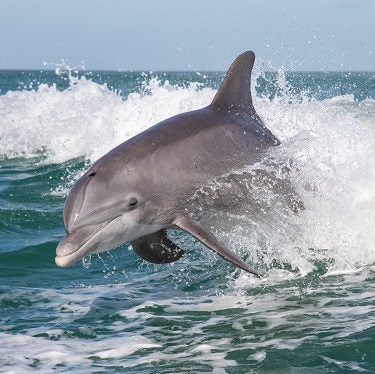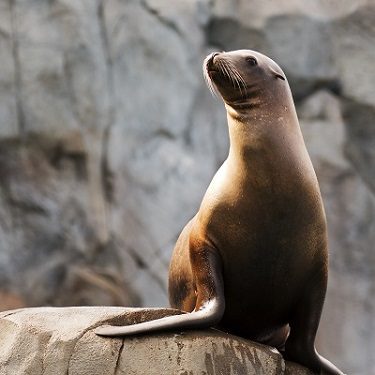Marine Life Encyclopedia
Marine Mammals
California Sea Lion
Zalophus californianus
Distribution
Eastern Pacific Ocean along North America coast
eCOSYSTEM/HABITAT
Coastal waters
FEEDING HABITS
Active predators
TAXONOMY
Class Mammalia (mammals), Order Carnivora (carnivores), Family Otariidae (eared seals)
Adult California sea lion females have tan fur, while males have dark brown fur. Females grow to a maximum length of 6.5 feet (2 m) and weigh 242.5 pounds (110 kg) on average. Males are three to four times larger than females, growing to a maximum length of 8.4 feet (2.5 m) and weight of 1,153 pounds (523 kg).1
California sea lions are very communicative creatures. They can often be heard barking like dogs in their large social groups made up of hundreds of sea lions. When they’re not lounging on beaches and rocky shores, California sea lions are hunting at sea for several days at a time.2 They are fast swimmers, reaching top speeds of 25 miles per hour (40 kmph) and can stay underwater for up to 10 minutes in pursuit of prey.3
While out at sea, California sea lions hunt alone or in small groups and eat a variety of prey, including Pacific sardines, anchovies, red octopus, jumbo and squid, mackerel and hake. California sea lions are also known to take fish from commercial and sport fishing gears. They can dive at least 1,312 feet (400 m) deep but tend to stay in shallower waters to find food. The sea lions may be preyed upon by orcas and sharks, as well as coyotes, feral dogs and bald eagles hunting for pups while on land.1
During the pupping and breeding season from May to July, California sea lions are on shore for longer periods of time. Males are highly territorial and polygynous. They establish breeding territories that include as many as 14 females4 and defend the territory against other males for up to 45 days.1 Females give birth to one pup a year after a gestation period of 11 months and are ready to mate again three to four weeks after giving birth. A mother will nurse her newborn pup for only one to two days before leaving to feed for two to five days. Mothers use unique vocalizations with their pups to locate them after their feeding trips. They continue this pattern of nursing and feeding every few days until the pup is weaned after about a year.4
California sea lions have experienced steady population growth over the past few decades since gaining protection under the Marine Mammal Protection Act in 1975. However, the species continues to be threatened by human activities. One of the biggest threats to California sea lions is entanglement in fishing gear. Gillnets, traps and pots can trap a sea lion, impairing their ability or swim or feed, as well as causing severe injury or death. Since they are at the top of the food chain, California sea lions may also be poisoned by pollutants in the coastal food chain that builds up in their bodies over time.
Finally, human-related injuries from harassers and people trying to feed the sea lions is a major threat. There are U.S. laws in place barring onlookers from touching, annoying or disrupting California sea lion behavior. Laws are also in place that aim to prevent people from feeding California sea lions because they learn to accept food handed to them and may change their natural hunting methods. Although they face many threats given their proximity to humans, California sea lion populations are considered stable and are listed as least concern by the IUCN.1
Fun Facts About California Sea Lions
1. California sea lions grow to a maximum length of 8.4 feet (2.5 m) and weight of 1,153 pounds (523 kg).
2. California sea lion males have been observed living for at least 19 years, while females tend to live longer around 25 years.1
3. California sea lions are the fastest of all seals or sea lions, swimming at top speeds of 25 miles per hour (40 kmph).
4. California sea lions can stay underwater for up to 10 minutes at a time.3
5. California sea lions are known for “rafting” – a resting technique sea lions use in the water where they lay motionless with their flippers above the surface for a long period of time.
6. California sea lions are very playful and can be seen body surfing.
7. California sea lions are the only species of sea lions whose population is currently expanding.2
Engage Youth with Sailors for the Sea
Oceana joined forces with Sailors for the Sea, an ocean conservation organization dedicated to educating and engaging the world’s boating community. Sailors for the Sea developed the KELP (Kids Environmental Lesson Plans) program to create the next generation of ocean stewards. Click here or below to download hands-on marine science activities for kids.
References:
Get Involved

Donate Today
SUPPORT OUR WORK TO PROTECT THE OCEANS BY GIVING TODAY
With the support of more than 1 million activists like you, we have already protected nearly 4 million square miles of ocean.

TAKE ACTION NOW
Support policy change for the oceans
Decision-makers need to hear from ocean lovers like you. Make your voice heard!

VISIT OUR ADOPTION CENTER
SYMBOLICALLY ADOPT AN ANIMAL TODAY
Visit our online store to see all the ocean animals you can symbolically adopt, either for yourself or as a gift for someone else.

DOWNLOAD OCEAN ACTIVITIES
HELP KIDS DISCOVER OUR BLUE PLANET
Our free KELP (Kids Environmental Lesson Plans) empower children to learn about and protect our oceans!




